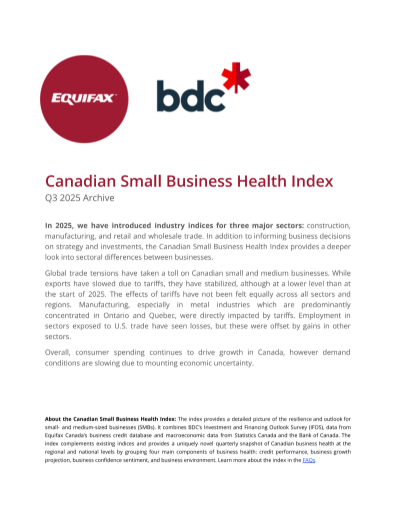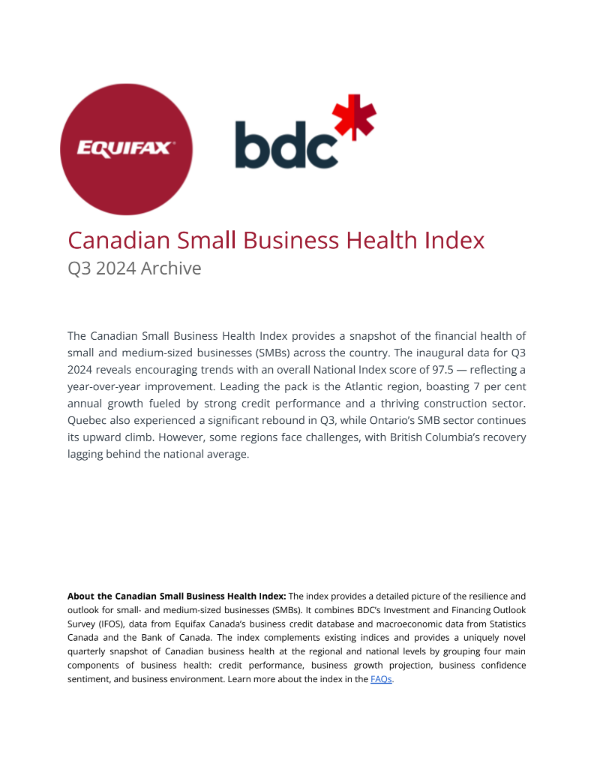The State of Canadian Small Business Health: Q3 2025 Performance
Canada: At an Economic Crossroads — Will Recovery Follow?
Canadian Small Business Health Index, Q3 2025
99.6
Year-over-year difference
1.1%
Difference over the previous quarter
2.8%
In the Canadian Small Business Health Index, the National index rose to 99.6 in Q3 2025, a 2.8% increase from the previous quarter. While uncertainty remained high, consumer spending and jobs held up despite weakness in the manufacturing sector. According to the index, the Canadian economy also showed some resilience to tariffs, which helped restore some confidence among SMBs. However, trade tensions reignited in the fall, and economic recovery continues to be on the minds of many businesses.
The quarterly rebound was driven by a 9.7% surge in sentiment and a 2.9% rise in growth projections, possibly indicating an increased optimism. General economic conditions for businesses improved as the effect of interest rate cuts were felt throughout the economy. Read the full report here.
Construction
The construction index stands at 96.0 in Q3 2025. It rose 2.6% quarterly and 4.6% annually. Read the full report here.
Manufacturing
The manufacturing index stands at 92.0 in Q3 2025. It declined by 2.1% quarterly and 1.5% annually. Read the full report here.
Retail and Wholesale Trade
The retail and wholesale sector performed best at 97.9 in Q3 2025, up by 4.5% quarterly and 6.2% annually. Read the full report here.
Regions: An Unequal Burden — Economic Effects Continue to Vary Across Provinces
Atlantic: Rebound amid strained economic environment
The index for the Atlantic region rebounded in Q3 2025 after hitting the lowest levels last quarter. While the level remains 2.5% weaker than a year ago, we’ve seen significant improvement when compared with Q2 2025. This signals that the impact from the U.S. tariffs has been relatively mild, and the employment rate and consumer spending has been favourable. Read the full report here.
Quebec: Recovering from peak uncertainty, but still cautious
The Quebec index stood at 100 in Q3 2025, reflecting a 4.2% quarterly increase, but a 1.2% decline compared to last year. Quebec remains directly exposed to tariffs, particularly on the aluminum and softwood lumber fronts. While the current outlook and financial health of SMBs improved compared to Q2 2025 when uncertainty peaked, the outlook remains weaker than last year. Businesses continued to face headwinds and business confidence remained tepid. Read the full report here.
Ontario: A solid and healthy bounceback despite continued tariff pressures
Ontario’s index rose to 98.9 in Q3 2025, a modest improvement of 1.4% quarter-over-quarter and 0.3% year-over-year. In Ontario, tariffs have had a large impact and are still putting pressure on wages, interest rates and consumer spending. Despite this, sentiment has improved over the last quarter, with a less pessimistic outlook on the economy and cashflows. The growth projection component also increased on a quarterly basis returning to its level at the start of the year as hiring, sales and investment expectations improved. Read the full report here.
Manitoba and Saskatchewan: Leading the pack, but financial strains remain
Manitoba and Saskatchewan: Leading the pack, but financial strains remain
At 105.5, the Manitoba-Saskatchewan index was the best-performing region in Q3 2025. It posted growth both on a quarterly (+2.3%) and an annual basis (+6.7%), driven by positive labour market trends. However, credit performance showed signs of weakness in Q3 2025. The growth projection component also fell 3.6% quarter-over-quarter, as businesses anticipate that they will invest and hire less over the next year. This may point to mounting pressure on SMBs despite continued growth in employment and wages. Read the full report here.
Alberta: Strong economic performance and improved outlook
The Index for Alberta rose to 103.4, a marked increase of 5.2% quarter-over-quarter and the largest uptick of any region in Q3 2025. This marked the highest level for the Alberta index since the start of recording in Q1 2022. Alberta is expected to have one of the strongest GDP growths in 2025 driven by a focus on investments in natural resource projects, and a relatively mild impact from tariffs. This has led to substantial improvements in business environment and sentiment components on a quarterly level. Credit performance also remained stable although at its lowest level compared to all other regions. Read the full report here.
British Columbia: Improving sentiment, weak outlook
The index in British Columbia reached 96.8 in Q3 2025, the lowest among all regions, but still 3.3% above last quarter, and 1.4% higher than a year ago. A lower exposure to U.S. trade and declining interest rates contributed to a more optimistic sentiment among SMBs. Retail sales in British Columbia were among the most robust in the country. However, growth projections and credit performance continue to lag, and with uncertainty still high, SMBs in British Columbia are scaling back investment plans in anticipation of weaker sales over the next year. Read the full report here.







